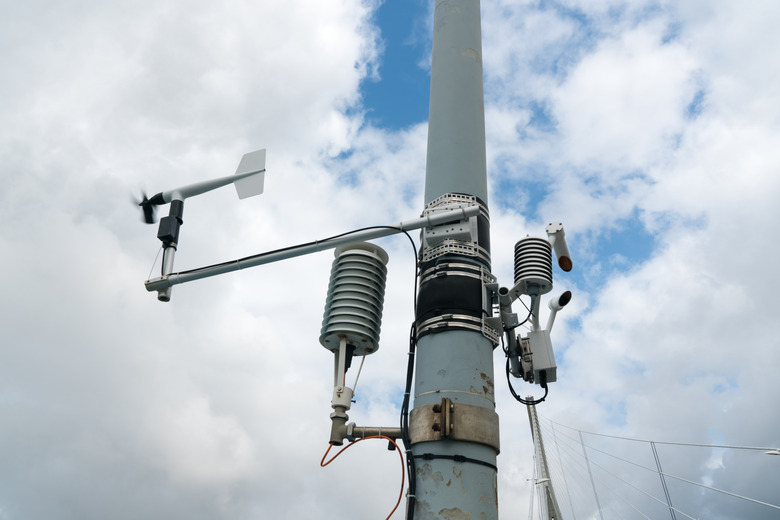How To Make A Weather Station Model
Constructing a weather station model can be a satisfying experience, similar to learning a secret language. Weather enthusiasts see these station models on both surface- and upper-level weather maps. Serving the purpose of accommodating space for all pertinent information from a multitude of weather stations onto a map, the station model is an essential tool. Familiarity with these weather maps and a cursory knowledge of weather will have you reading and assembling weather station models in no time.
Step 1
Draw a circle. Look at the sky and divide it into eighths. Fill in the circle based on how many eighths of the sky are covered with clouds. A clear circle represents a station with no clouds observed; a full circle is an overcast sky over the weather station.
Step 2
Connect a line to the circle extending toward the direction the wind is coming from. Draw a long line connecting and perpendicular to the tip of the first line to represent a 10-knot wind speed. Draw a shorter line for 5 knots and a flag for 50 knots.
Step 3
Determine the temperature and dew point of your weather station. Record the temperature in degrees Fahrenheit just to the left of the wind barbs. Record the dew point under the temperature, just beneath the circle and to its right.
Step 4
Plot the symbol for current weather just to the left of the station model circle. Place the visibility in miles to the left of the current weather symbol.
Step 5
Record sea level pressure to the nearest tenth of a millibar in the upper right of the station model circle. Place only the last three digits of this number on your weather station model.
Step 6
Place the pressure change to the nearest tenth just below your current sea level pressure record. Signify a pressure increase with a plus sign and a decrease with a negative sign.
Things Needed
- Drawing tool
- Access to weather data
- Weather station model current weather symbol guide
TL;DR (Too Long; Didn't Read)
The National Weather Service uses 7 miles as the maximum visibility. Have reference points at your weather station to assist with visibility.
Warning
Note that the average sea level pressure is between about 930 and 1050 millibars; thus, a recording of 298 is assumed to be 1029.8, as opposed to 929.8, unless there is an abnormal event such as a hurricane near the weather station.
Cite This Article
MLA
Shepard, Don. "How To Make A Weather Station Model" sciencing.com, https://www.sciencing.com/make-weather-station-model-4896178/. 22 November 2019.
APA
Shepard, Don. (2019, November 22). How To Make A Weather Station Model. sciencing.com. Retrieved from https://www.sciencing.com/make-weather-station-model-4896178/
Chicago
Shepard, Don. How To Make A Weather Station Model last modified March 24, 2022. https://www.sciencing.com/make-weather-station-model-4896178/




